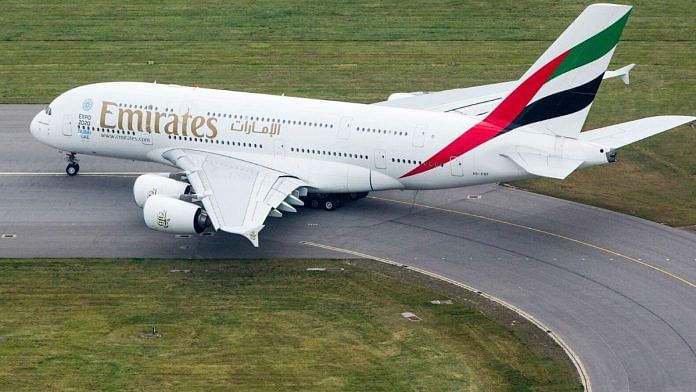Much as Pan Am Corp. was an emblem of the first wave of global aviation, Emirates has dominated the world airline industry for a generation. Its announcement that almost all passenger flights will be suspended from Wednesday marks the death knell of that era.
The Dubai-based carrier is the largest airline by international passenger traffic, with the capacity to move its customers 391 billion seat-kilometers last year. In terms of cross-border traffic, that’s twice the capacity of any U.S. airline and about a seventh more than the three European carriers that are its closest international competitors in terms of scale.
The shutdown of that vast network is a hammer-blow not just for the industry but for people around the world. There’s a reason so many airlines are (like Emirates) state-owned, or have special rights and duties to their home countries written into their constitutions. They aren’t just a leisure service, they’re a piece of vital national and international infrastructure that can provide an airlift service in an emergency. Emirates’ initial announcement of a complete suspension of flights Sunday was subsequently updated to say that some destinations would remain open “having received requests from governments and customers to support the repatriation of travellers.”
Businesses that thrive on bustling cross-border traffic are inevitably going to struggle in current conditions. Cathay Pacific Airways Ltd., another carrier that, like Emirates, has no domestic aviation market, last week announced it was cutting 96% of capacity in April and May, which is as close as you can get to shutting down. Qantas Airways Ltd. is also ending international flights and Emirates’ local rival Etihad Airways PJSC has made drastic cuts to its schedules.
We’ve seen something like this before. Pan Am went bankrupt amid the collapse in air travel that accompanied the 1991 Gulf War; its competitor Trans World Airlines Inc. entered the first of many Chapter 11 processes around the same time. Another wave of bankruptcies and rescue takeovers followed after the Sept. 11 attacks, and again after the 2008 financial crisis. More than a decade on from that, we’re probably overdue for another shakeout.
That certainly looks like what we’re going to get. “Most airlines in the world” will be bankrupt by the end of May at current rates of cash burn, according to consultants CAPA Centre for Aviation. The industry needs about $200 billion in bailout money if it’s to survive, according to the International Air Transport Association, the largest group representing airlines.
Emirates has some serious weaknesses as it approaches this perfect storm. Dubai’s status as the preeminent hub in the global network of transfer passengers, and its fleet of capacious twin-aisle jets, are as much a product of the recent era of promiscuous globalization as Pan Am’s fleet of gas-guzzling early-model 747s were a product of the era before the 1973 oil crisis.
On an immediate level, that means it lacks even the meager domestic aviation cashflows that rivals in the U.S., China and elsewhere can fall back on. In the longer term, there’s the risk that Covid-19 and the Trump-driven trade wars that preceded it raise drawbridges across the world, leaving behind a dark mentality of xenophobia as gates are closed to outsiders. In that grim future, Emirates’ Benetton catalog-tinged vision of a multicultural world shaking hands at Dubai airport looks as outdated as, well, shaking hands.
Even if things return to a semblance of normalcy at some point, Emirates’ golden years are behind it – a fact that neatly coincides with the upcoming retirement of Tim Clark, who led the airline since its inception.
Rivals with bigger domestic markets have already been looking to use longer-haul 787s and A350s to skip past hub airports like Dubai altogether. The A320neo and the 737 MAX, should it recover from its current woes, will also bite off pieces of medium-haul traffic with budget carrier-style prices, undermining key routes into Europe and South Asia.
Emirates still has some advantages in facing the coming conflagration. Unlike Etihad and Qatar Airways, it has never reported a loss in financial reports dating back to 1989. That’s a fairly extraordinary result for an airline that’s been around for so long — although there’s still a week still to go on its current financial year.
Most importantly, though, the only shareholders it answers to are Dubai’s ruling Al Maktoum family. For decades, they’ve regarded the carrier as a crucial element of their oil-poor emirate’s strategy for a long-term economic future. With crude prices currently south of $30 and Gulf monarchies edging alarmingly close to burning through their own petrocash piles, that bet looks as sound as it’s ever been.
If aviation is about to be crippled by a virus-driven resurgence of nationalism, it’s the carriers most closely bound up with their governments that stand the best chance of survival. –Bloomberg
Also read: Coronavirus strands super rich Indians as they can’t fly home even on private jets



